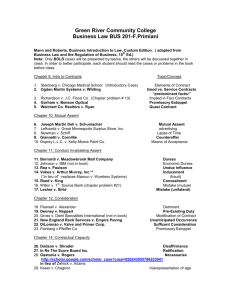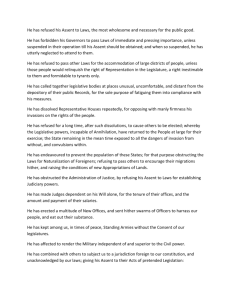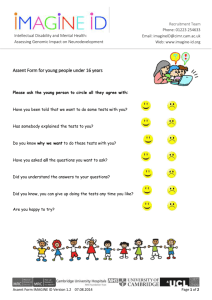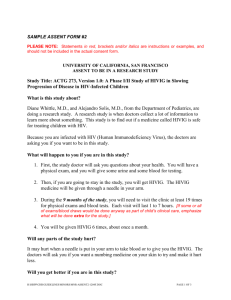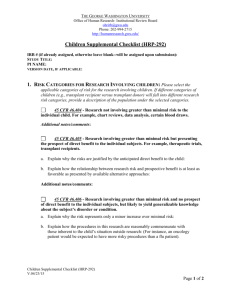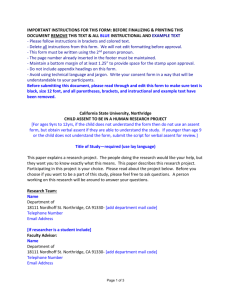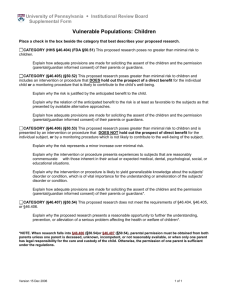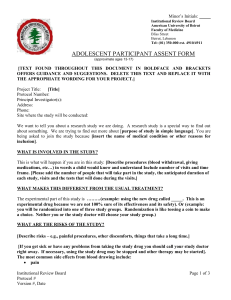Child Assent and Parent Permission - CPHS
advertisement
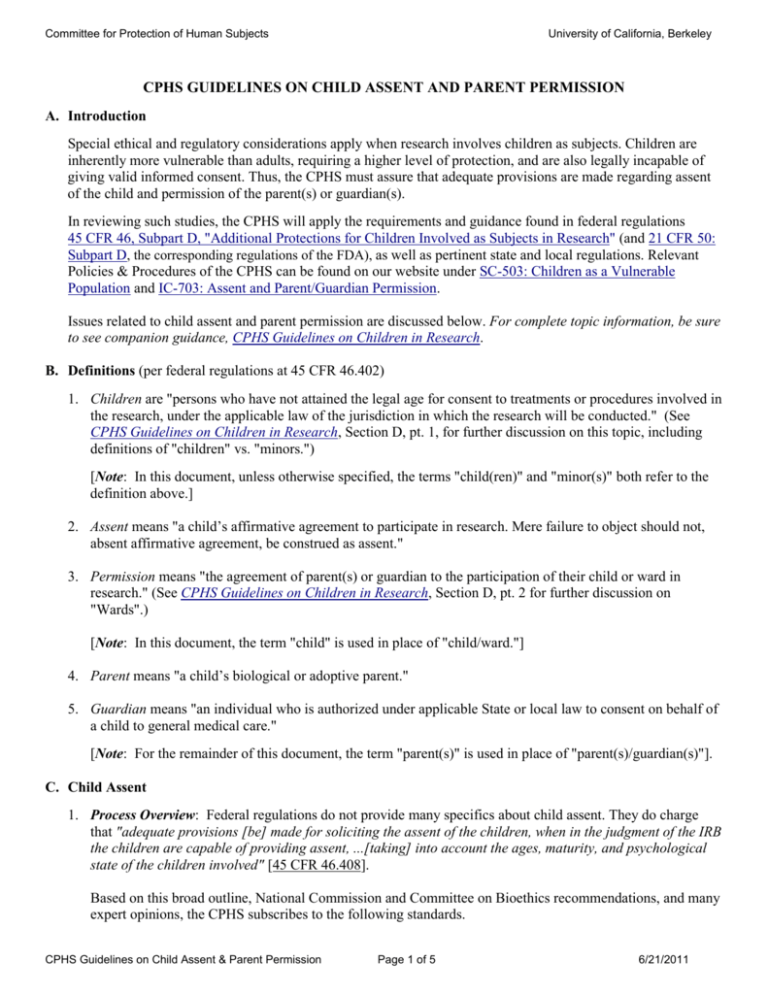
Committee for Protection of Human Subjects University of California, Berkeley CPHS GUIDELINES ON CHILD ASSENT AND PARENT PERMISSION A. Introduction Special ethical and regulatory considerations apply when research involves children as subjects. Children are inherently more vulnerable than adults, requiring a higher level of protection, and are also legally incapable of giving valid informed consent. Thus, the CPHS must assure that adequate provisions are made regarding assent of the child and permission of the parent(s) or guardian(s). In reviewing such studies, the CPHS will apply the requirements and guidance found in federal regulations 45 CFR 46, Subpart D, "Additional Protections for Children Involved as Subjects in Research" (and 21 CFR 50: Subpart D, the corresponding regulations of the FDA), as well as pertinent state and local regulations. Relevant Policies & Procedures of the CPHS can be found on our website under SC-503: Children as a Vulnerable Population and IC-703: Assent and Parent/Guardian Permission. Issues related to child assent and parent permission are discussed below. For complete topic information, be sure to see companion guidance, CPHS Guidelines on Children in Research. B. Definitions (per federal regulations at 45 CFR 46.402) 1. Children are "persons who have not attained the legal age for consent to treatments or procedures involved in the research, under the applicable law of the jurisdiction in which the research will be conducted." (See CPHS Guidelines on Children in Research, Section D, pt. 1, for further discussion on this topic, including definitions of "children" vs. "minors.") [Note: In this document, unless otherwise specified, the terms "child(ren)" and "minor(s)" both refer to the definition above.] 2. Assent means "a child’s affirmative agreement to participate in research. Mere failure to object should not, absent affirmative agreement, be construed as assent." 3. Permission means "the agreement of parent(s) or guardian to the participation of their child or ward in research." (See CPHS Guidelines on Children in Research, Section D, pt. 2 for further discussion on "Wards".) [Note: In this document, the term "child" is used in place of "child/ward."] 4. Parent means "a child’s biological or adoptive parent." 5. Guardian means "an individual who is authorized under applicable State or local law to consent on behalf of a child to general medical care." [Note: For the remainder of this document, the term "parent(s)" is used in place of "parent(s)/guardian(s)"]. C. Child Assent 1. Process Overview: Federal regulations do not provide many specifics about child assent. They do charge that "adequate provisions [be] made for soliciting the assent of the children, when in the judgment of the IRB the children are capable of providing assent, ...[taking] into account the ages, maturity, and psychological state of the children involved" [45 CFR 46.408]. Based on this broad outline, National Commission and Committee on Bioethics recommendations, and many expert opinions, the CPHS subscribes to the following standards. CPHS Guidelines on Child Assent & Parent Permission Page 1 of 5 6/21/2011 Committee for Protection of Human Subjects University of California, Berkeley The process of asking a child to participate in research should be carefully planned and implemented, using age-appropriate language and methods, for any child who is considered capable of understanding and providing assent. This process should include a clear explanation (verbally, and in written form when applicable) that conveys: what the study is about; why the child is eligible/being invited to participate in the study; procedures the child will be expected to take part in; potential risks and/or discomforts to the child; potential benefits to the child or society; that the child is completely free to choose whether or not to participate, and may withdraw at any time without negative consequences; an invitation to ask questions at any time; and names and contact information (phone numbers, email addresses) of whom to contact with questions. Note: See CPHS template assent forms for assistance. Assent language must be tailored to the reading and comprehension level(s) of the subject populations to be enrolled and will vary widely from study to study. When verbal assent only is proposed, an assent script (containing some/all of the elements listed above) may be advised. Multiple methods of explaining the study should be used as suitable, e.g., videotapes, online presentations, written materials, diagrams, etc. Younger children are likely to understand verbal explanations better if they are accompanied by concrete examples that the child can relate to past experience. Each child, if capable, should have the opportunity to sign an assent form and take a copy home to review later. The federal regulations do not recommend that assent be sought starting at a specific age (although California law requires assent for experimental medical procedures "if the subject is seven years of age or older" [CA Health & Safety Code §111530]). The CPHS agrees that, in most cases, seven years of age is a reasonable minimum for a child with normal cognitive development to be capable of participating in a meaningful written assent process, and that many adolescent minors (13 to 17 year olds) will be able to participate in a written assent process that is similar to that of adult consent. (See further discussion below.) The Committee also agrees that dissent of a child (i.e., their actual objection to research) should be considered binding, especially in non-therapeutic research. (There are rare exceptions, e.g., where a study may offer direct medical benefit to a younger child. See additional information below, under 3-Waiver of Child Assent, Waiver Criteria under 45 CFR 46.408.) In general: If the child is considered capable of being involved in the informational process (regardless of age), at least a simple verbal explanation of what will happen to him/her and the opportunity for questions and discussion should be given. Even if the requirement for assent is waived (see Waiver of Child Assent below), it is always preferable to involve the child in the process as much as possible. An appropriate assent form should be used whenever feasible (see CPHS template assent forms). Assent forms should be written at a level of education and maturity appropriate to that of the youngest prospective subject in the age range, and the information delivered using suitable methods. (When verbal assent only is proposed, an assent script may be advised.) At a minimum, there must be documentation on the parent permission form and/or in the study records that the child was informed about the study. (See Section E: Documentation of Assent and Permission). 3. Waiver of Child Assent: CPHS Guidelines on Child Assent & Parent Permission Page 2 of 5 6/21/2011 Committee for Protection of Human Subjects University of California, Berkeley The CPHS is responsible for deciding whether child assent is required in a proposed research activity. The Committee will require child assent unless it determines that the research satisfies one of these conditions: Waiver Criteria under 45 CFR 46.408: The capability of some or all of the children is so limited that they cannot reasonably be consulted; OR The research holds out a prospect of direct benefit that is important to the health or well-being of the children and is available only in the context of the research. Even where the CPHS determines that the children are capable of assenting, it may still waive the assent requirements under circumstances in which consent may be waived for adults: A. Waiver Criteria under 45 CFR 46.116(c): (1) The research or demonstration project is to be conducted by or subject to the approval of state or local government officials and is designed to study, evaluate, or otherwise examine: (i) public benefit or service programs; (ii) procedures for obtaining benefits or services under those programs; (iii) possible changes in or alternatives to those programs or procedures; or (iv) possible changes in methods or levels of payment for benefits or services under those programs; AND (2) The research could not practicably be carried out without the waiver or alteration. OR B. Waiver Criteria under 45 CFR 46.116(d): (1) The research involves no more than minimal risk to the subjects; (2) The waiver or alteration will not adversely affect the rights and welfare of the subjects; (3) The research could not practicably be carried out without the waiver or alteration; and (4) Whenever appropriate, the subjects will be provided with additional pertinent information after participation. Note: Investigators wishing such waiver should propose a waiver of child assent, providing rationale/ justification (based on one of the criteria described above) in the Child Assent and Parent Permission section of the CPHS application. D. Parent Permission 1. As with child assent, federal regulations do not provide many specifics about parent permission. They do indicate whether permission from one or both parents is required for each category of permissible research (see CPHS Guidelines on Children in Research), and also speak to circumstances in which parent permission may be waived (see Waiver of Parental Permission below). In most cases, the CPHS expects that the parent(s) will play a vital part in the consent process for research involving their child. The investigator should make every effort to assure that both the parents and child understand the research, and their respective rights, as thoroughly as possible. This includes conveying to parents that they should respect their child's autonomy in this regard (e.g., not exert overt or implied pressure for the child to participate, not indicate anger or disappointment if the child wishes to decline or withdraw from the study). Usually, the parent(s) must be provided with a permission form that meets all requirements for adult consent, but is written to refer to the subject as "your child" instead of "you." 2. When Parents Disagree: If there are two parents available to give permission and the researcher becomes aware that they disagree about allowing their child to participate in the study, the child may not be enrolled unless that disagreement can be resolved. (This applies to all permissible categories; i.e., even if only one parent’s signature is required, when both parents are involved in the decision, they must agree in order for the child to participate). CPHS Guidelines on Child Assent & Parent Permission Page 3 of 5 6/21/2011 Committee for Protection of Human Subjects University of California, Berkeley 3. Waiver of Parent Permission: The CPHS may waive the requirements for obtaining parent or guardian permission for research involving children if EITHER of the sets of conditions outlined below is met. Under 45 CFR 46.116(c) or 46.116(d) (See above under Waiver of Child Assent). Under 45 CFR 46.408: The CPHS may waive the requirement for permission if it finds that "a research protocol is designed to study conditions in children or a subject population for which parent or guardian permission is not a reasonable requirement to protect the subjects (for example, neglected or abused children)." Research on neglected or abused children is one example for possible waiver; the CPHS interprets this regulation as also applying to people under 18 years of age who are in circumstances where they are clearly outside of parental influence or control (though not legally able to consent for themselves). The Committee will evaluate each waiver request carefully to determine if "parent or guardian permission is not a reasonable requirement to protect the subjects" in that case. To grant any waiver under 46.408, the Committee must also find that: "(i) an appropriate mechanism for protecting the children who will participate as subjects in the research is substituted; and… (ii) the waiver is not inconsistent with Federal, State, or local law. The choice of an appropriate mechanism [will] depend upon the nature and purpose of the activities described in the protocol, the risk and anticipated benefit to the research subjects, and their age, maturity, status, and condition." Note: Investigators wishing such waiver should propose a waiver of parent permission, providing rationale/ justification as indicated in the Child Assent and Parent Permission section of the CPHS application. Regarding FDA regulations: No informed consent requirements can be waived for studies regulated by the FDA, except under the FDA emergency treatment or emergency use exception. E. Documentation of Assent and Permission The regulations indicate that parent permission must be documented as required for adult consent (per §46.117). Regarding child assent, the regulations state: "When the IRB determines that assent is required, it shall also determine whether and how assent must be documented." (§46.408 (e)) 1. The CPHS recommends the following general guidelines for permission and assent by age group of the child subjects, and documentation thereof. Note: The CPHS template assent and permission forms can be adapted for use in most studies, using these categories as a basis. a. Children up to 7 years old: Children in this age range may not be able to participate in a written assent process, or if very young or otherwise incapable, in any meaningful assent process. In such cases, only a permission form for the parents will be required. This form should be adapted from the CPHS template parent permission forms. Note: In many cases, the investigator may deem a child younger than 7 years old capable of being involved in the assent process. If so, the investigator should make sure that the child is given a simple explanation of what will happen to him/her, and that there is documentation on an assent form/script, the parent permission form, or in the study records that this was done. b. Children 7 to 12 years old: In most cases, children this age will be able to participate in the assent process using a simplified assent form (adapted from the CPHS template assent forms for 7-12 year olds). The child should sign the form if possible. If not, the form or study records must still document that verbal assent was obtained. CPHS Guidelines on Child Assent & Parent Permission Page 4 of 5 6/21/2011 Committee for Protection of Human Subjects University of California, Berkeley A separate, more detailed permission form will be needed for the parents, adapted from the CPHS template parent permission forms. c. Adolescents 13 to 17 years old: In most cases, adolescents should be fully informed about a study and give signed assent to their own participation in the research. An assent form should be written for the adolescents, adapted from a CPHS template assent form for 13-17 year olds. Depending on the complexity of the study and the condition/capacity of the adolescent subject, this assent form may be very similar to the parent permission form, or it may need to be somewhat simpler than the adult's form. In some cases, e.g. where the parent permission form will be identical in content to the adolescent assent form, the investigator may propose using one form, with signature lines for the adolescent's assent followed by the parent's permission. The form should be adapted from a CPHS template assent form for 13-17 year olds, and address the adolescent subject throughout as “you.” 2. Waiver of Documented (Signed) Permission: The CPHS may waive the requirements to obtain documented (signed) parent/guardian permission under the same conditions that apply to waiving signed consent from adult subjects. Per 45 CFR 46.117(c), the CPHS must find either: (1) That the only record linking the subject and the research would be the consent document and the principal risk would be potential harm resulting from a breach of confidentiality; OR (2) That the research presents no more than minimal risk of harm to subjects and involves no procedures for which written consent is normally required outside of the research context. The investigator must request this waiver by selecting "Unsigned Parent/Guardian Permission" as the "Type of Permission" in the CPHS application. (As signed assent is not required under the regulations, a formal waiver of signed assent need not be requested. However, the PI should make clear in the application whether or not signed assent will be sought and why.) Note: As the regulations indicate, in cases where the documentation requirement is waived, the IRB may still require the investigator to provide subjects with a written statement regarding the research. The CPHS will usually expect such an unsigned "information sheet" to be used in place of a consent or permission form. CPHS Guidelines on Child Assent & Parent Permission Page 5 of 5 6/21/2011
